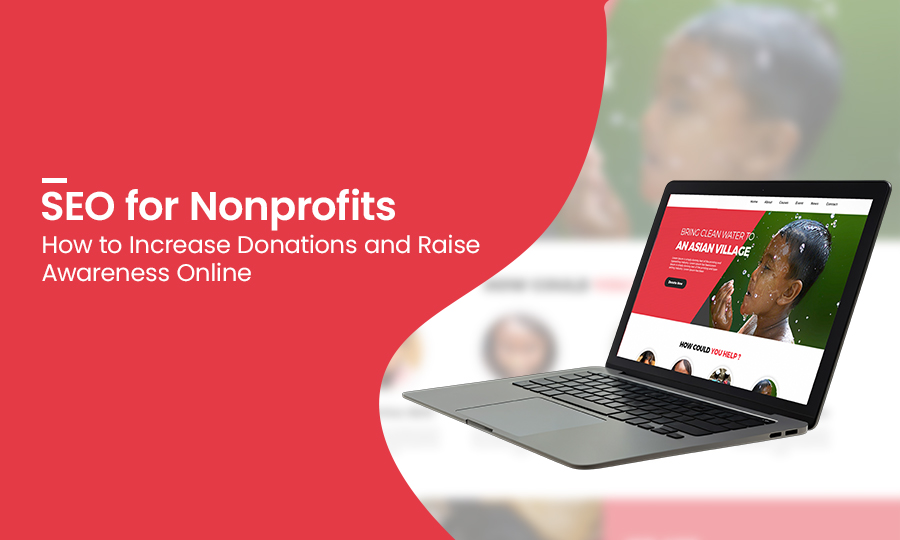In today’s fast-paced technological advancement and digital age, nonprofit organizations often feel pressure to boost their online visibility in Google search With the number of organizations seeking to gain attention online, it indeed becomes tough for them to find more donors and volunteers. So, what’s the solution? Well, the SEO for nonprofits is the right solution.
A survey reveals that approximately 37% of nonprofit already implemented an effective search engine optimization (SEO) strategy. It reflects the importance of the unmatched potential of online marketing to build awareness for their causes.
Many online fundraising platforms have already made it convenient for businesses to accept donations online, while creating a smooth experience, be it for donor or recipient. Apart from this, integrating many digital tools has also redefined the nonprofit’s engagement with supporters and thus opened up a world of various possibilities.
So, you might be thinking of the right way to get maximum SEO for your nonprofit, right? This post is the one-stop destination to get the right answer. But, before going in-depth into strategies, it’s crucial to start from the basics.
What is SEO for Nonprofits?
When it comes to SEO for nonprofits, it’s an important practice that involves maximizing the visibility of nonprofit. It maximizes the appearance of your website in search engine result pages (SERPs). It’s one of the key strategies to reach organic website visitors who seek to learn about necessary support and opportunities for many nonprofit organizations.
Organic traffic is traffic that you don’t need to pay for. It comes from those people seeking to find your SEO content when they look for various things using Google. For instance, NGOs appear when users search using keywords like ‘legal aid NGO in Boston’.
Organic traffic is helpful for nonprofits to spread the word about their services, raise awareness, and get volunteers about many specific issues. Apart from this, a large number of traffic also helps nonprofits to entice donors and thus increase fundraising efforts.
The most interesting thing about SEO is it’s an affordable marketing method in the long run when compared to paid ads and many other channels. It creates trust and reliability by offering people useful website content in their moment of necessity.
Importance of SEO for Nonprofit Organizations
The majority of nonprofit operate under a limited budget and resources. So, their every marketing effort is of great importance. A perfectly implemented SEO strategy is important to offer great value by increasing organic traffic to your websites.
When your website appears at the top in the search engine result pages, it helps you build trust and credibility for your nonprofit. Apart from this, it also brings the following important benefits;
- Maximize your reach among your Target Audience
SEO gives you a chance to use relevant keywords and thus optimize your website content. It ensures your messages reach your targeted individuals who are interested in your practices. It also lets you get in touch with your targeted audience segments.
- Get a Complete Control of your Message
Google Ads provides a good thing for nonprofit. Meanwhile, it includes many rules that make it tough several times to increase visitors to your nonprofit website’s requirements. There’s indeed no restriction on content with search engine marketing.
- Boost User Experience
Implementing great SEO practices is indeed quite beneficial in improving user experience on your website. It reflects easy navigation, quick loading times, relevant content, mobile-friendly design, etc. These address user requirements.
- Long-Term Growth
SEO is completely different when compared to paid campaigns. It ensures long-term and sustainable growth. On the other hand, paid campaigns cease to boost traffic once your budget gets exhausted. So, nonprofits can generate more visitors to your website organically through top-quality content creation It ensures maintaining a powerful online presence.
Tips to Build Effective SEO Strategies for Nonprofit Organizations
To make your SEO campaign successful, you need to chalk out effective SEO strategies
that ensure your success. We have discussed the following important strategies that yield desired search results. Let’s explore all of them one by one.
- Know your Target Audience

Before developing an SEO effort, you need to be familiar with your target audience. Nonprofit serves the sole purpose of environmental conservation. So, your target audience should be those who are environmentally conscious, nature enthusiasts, or also those who are keen on sustainable living.
Being a nonprofit, you may know your target audience may consist of those people who support your cause through volunteering. And also those who support you through donations or sponsorship.
There may indeed be different audiences who are keen on different topics. Make sure you speak to everyone through your video and written content. Once you are fully aware of the needs and motivations of your target audience, you can easily tailor your search engine marketing strategy accordingly.
- Perform an In-Depth Keyword Research
Keywords are basically those terms people use to search for specific and important information in search engines. For instance, those who look for nonprofit often searches for ‘local charity near me’. It helps them find the right nonprofit organization that they can support.
Therefore, you need to focus on keyword research to decide the right keywords that make sense for your nonprofit. It’s something that depends on your goal or the audience you wish to reach. Here are some of the effective ways to find keywords for your nonprofit;
Steps to Select the Right Keywords
- Always Start with Broad Terms
The first and easiest way of keyword research for your organization is to find specific and long-term variations. You can leverage various keyword tools including Semush, Aherfs, Kyeword Planners, and others.
Once you decide on the right keyword finder tools to use, you need to insert the broad terms. For instance, you can go with ‘nonprofit donations’. After this, you can push the ‘search’ option. Your next step is to filter the complete keyword list.
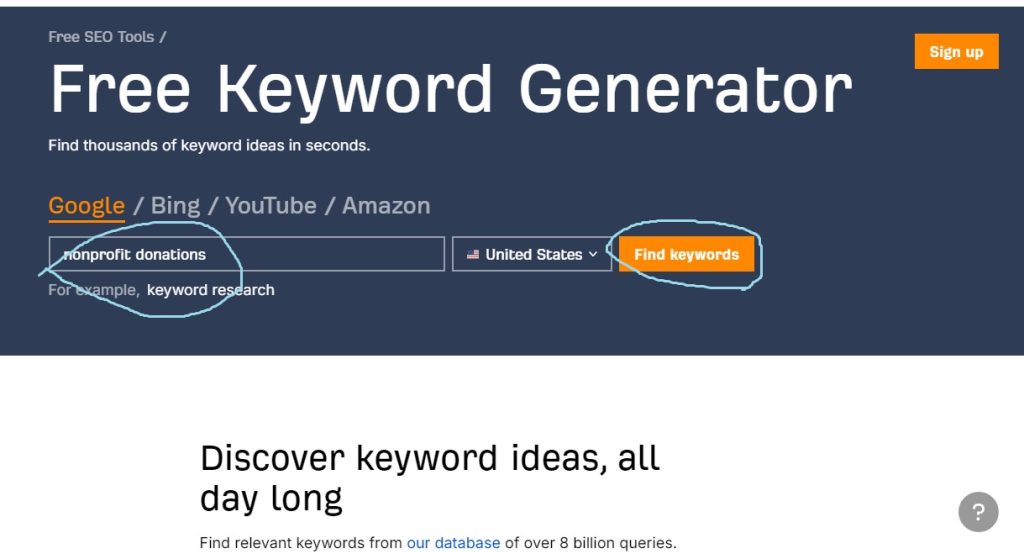
Let’s explore three important filters you can consider to use while performing keyword research;
- Keyword Difficulty (KD)
It reflects how tough it would be to rank highly for any particular keywords. At the start, you wish for keywords with lower KD percentages since they can rank hassle-free. Make sure the KD is less than 30%.

- Search Volume
With the search volume, you get a correct estimation in terms of the number of times keywords are used on a monthly basis. You wish keywords get at least 100 searches.
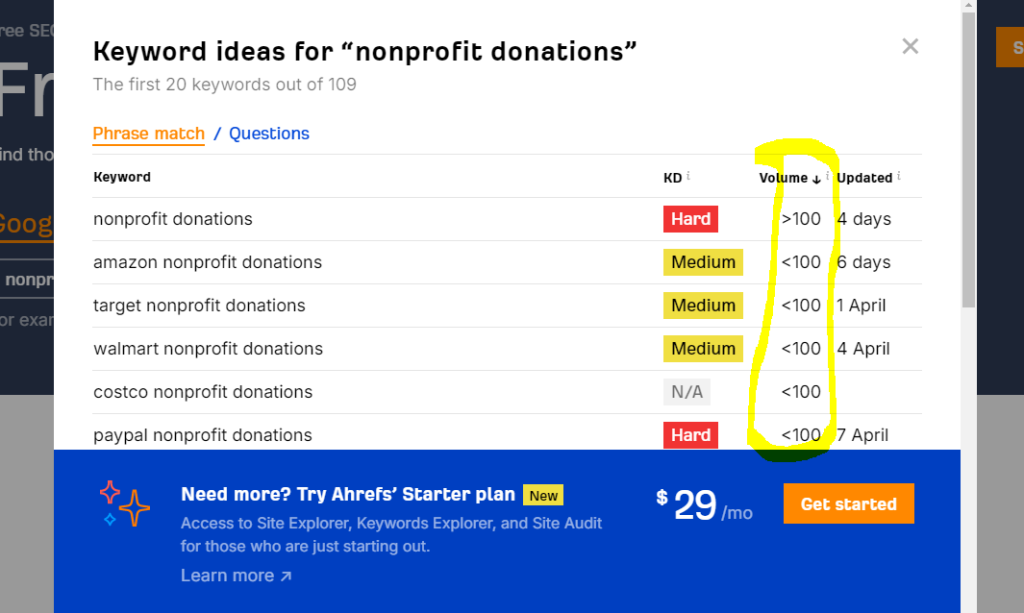
- Word Count
Word count lets you understand how short or long a keyword is. Longer keywords are generally more specific and also have less KD%. Therefore, you need to target those keywords with three or more words. It’s advisable to click on the KD%. So, you will be able to see keywords with ‘easy’ and ‘very easy’ difficulties.
- Look at Top-Ranking Articles
The next important way of finding keywords is to search for top-ranking articles. You need to search for some words and search queries on Google related to what your nonprofit does. After this, you can analyze several pages that appear in the Google search results with a keyword searching tool.
- Look at What Your Competitors Rank for
Another way of finding relevant keywords is to search for relevant queries of your competitor’s rank. Here, you can also get help from the ‘Keyword Gap’ tool.
You need to enter your website’s and competitor’s domain and then press the button ‘compare’.
Each keyword can be chosen, and then added to your list of keywords. You can also make just manual notes of keywords you wish to create content around. The most important tip you need to consider is that every keyword has a specific search internet. That’s the reason why people always search for a specific term in terms of what sort of content they hope actually to find.
An easy way to find search intent is to look at the type of content that ranks in search results with the given term. It gives you a perfect idea in terms of topics you need to cover in terms of the angle you take, and also the right format to rank those keywords.
- Create Quality Content
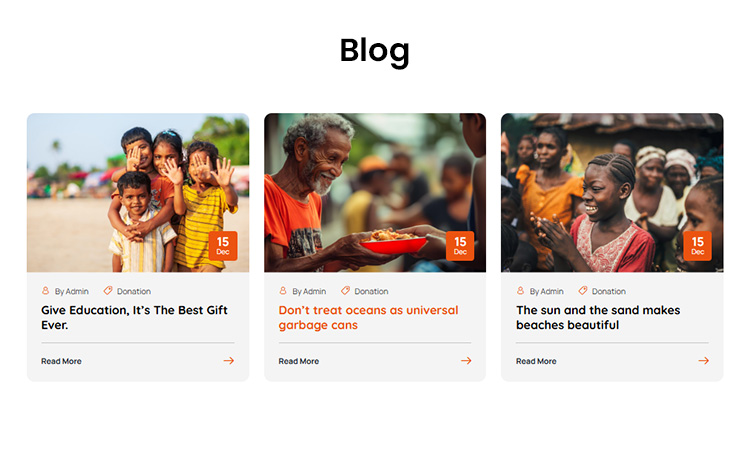
We all are aware of the importance of quality content when it comes to search engine optimization. The most important thing you need to keep in mind is search engines are becoming smarter day by day. It reflects the most relevant results to their customers based on several factors – content is indeed one of those.
It’s advisable to publish relevant and top-quality content that aligns perfectly with the interest and requirements of your audience. It’s indeed quite necessary to create different types of content, including infographics, blog posts, videos, guides, etc. It indeed engages your audience.
For nonprofits, you need to create content on those topics that are related to sustainable living tips, ways to minimize plastic waste, the importance of biodiversity, and more. With the incorporation of your target keywords within the content, search engines recognize your website as an important resource and rank high in SERPs.
Let’s explore several important tips and tricks to improve the quality of your content;
- Make sure every page has a unique primary keyword. You need to target broad industry terms on your home page. Be it product pages, category pages, or articles, everything should target more specific niche requirements.
- You need to look at a complete list of many SEO keywords and also the type of previous posts you can work those important keywords into.
- You need to always interview both influencers and experts. They are indeed likely to share your content with the help of their social channels.
- You need to always write engaging, unique, fresh, and quality blog posts that relate to your work. It’s important for nonprofit sectors to showcase volunteers, beneficiaries, share images, videos, testimonials, reviews, and more.
- You need to always minimize and remove aggressive pop-ups and also make your images small.
- You should always create different types of content, including videos, blog posts, infographics, lists, guides, and more.
- Optimize On-Page Elements
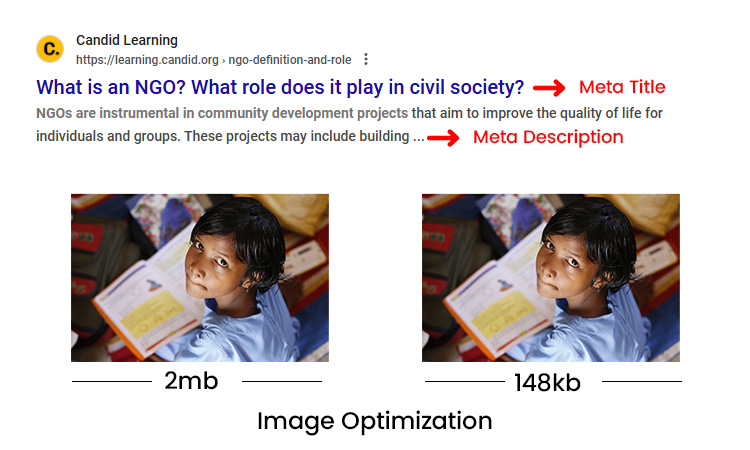
On page search engine optimization is a process to optimize different parts of webpages to increase their organic traffic and search engine rankings. It includes several things such as internal linking, URLs, title tags, and many more.
Let’s explore various important on-page SEO elements;
- Target Keyword Optimization
You can naturally use your target keywords. It also includes several key spots. These include the title, URL, first paragraph, and also throughout the body of the content, etc. Besides, you can also use your target keywords in some of your subheadings.
- Title Tags
Make sure you keep your page titles between 50 and 60 characters long. It ensures they are unique and also incite searcher’s interest.
- Headers
You can use the H1 tag in your page title and H2s to reflect sections, while H3s and H4s can be used to further structure long-form content and also make it fully skimmable.
- Meta Description
Make sure your meta description is less than 105 characters long while including your target keyword and also adding a call-to-action phrase.
- URL Structure
It’s advisable to use simple URLs with no random numbers, full sentences or publish dates. It gives ideas to readers in terms of what the page is about.
- Image Optimization
You need to compress images, which help them load fast with the use of tools including ImageOptim. To make it easier for search engines and users—especially those who are blind or visually impaired—to comprehend what an image is about, you must utilize alt text.
- Internal Linking
You need to always search for various opportunities to link to new content from those of your existing pages and also the other way around. You should always update any URLs that have either been removed or changed.
- Schema Markup
The next important thing you need to do is to add schema markup and codes describing elements on your website. It allows search engines to understand your content better. It can certainly reflect rich snippet results, including star ratings, opening hours, and more.
- Technical SEO

When it comes to technical search engine optimization, it’s an important process to make your website easy to navigate. Besides, it also makes it easy to understand for both users and search engines. Technical search engine optimization also improves things in terms of how quickly your website loads.
Whether its mobile responsiveness, website speed, sitemaps, or website structure, many important technical SEO elements deserve your attention. It influences how your website ranks better in search organic search results.
Website Speed
Website speed is one of the important search engine ranking factors be it for desktop or mobile devices. You can leverage tools including PageSpeed Insights to check in terms of how quickly your webpages load. Following are the things you can do to improve page speed;
- Compress both images and videos
- Use caching
- Remove unnecessary plugins
Mobile Responsiveness
It’s highly important since Google uses mobile page experience in its search ranking algorithms. One of the important ways to check if your website offers a great experience to mobile visitors is with the use of website audit tools by Semrush and others.
These tools are easy to use and highlight issues depending on your core focus. It’s advisable to focus on the ‘error’ first and also the way to fix the same. A perfect site structure is indeed useful for search engine crawlers to find and also get a complete understanding of your content.
It facilitates users to navigate your website properly. An effective usage of internal links is helpful. It also works well to prevent orphan pages. These URLs don’t include any internal links pointing to them.
Website Sitemaps
Website sitemaps are basically files that include URLs of important pages of your website. You want Google to crawl these pages, while indexing and serving various search results.
Site Structure
Site structure is an indication of how your website is organized. Make sure the structure of your website is hierarchical and logical. Therefore, it’s highly important for you to use proper internal linking strategy and also logical site navigation.
- Make your Website User-Friendly
Google always pays complete attention to the user experience (UX) of your website. So, you need to always focus on these things. Besides, you should never ignore other factors such as an intuitive user interface (UI), and use an easy-to-navigate design. Also, you should focus on the following important technical SEO issues;
Page Speed
Make sure your pages load quickly even within two seconds. If it takes a longer time, users may avoid visiting your website. It eventually increases the bounce rate of your website.
- Be it headings, small paragraphs, or sub-headers, a perfectly structured content helps you win over the competitive keywords.
- Make sure your website responds based on users’ input in less than 100 milliseconds.
- With the number of donors using smartphones to make donations, mobile optimization is something that keeps a great importance.
- Focus on Creating Backlinks

Backlinks are another factor that have a direct contribution to improving the search engine ranking of your website. It’s a great idea to target only those high-authority and other reputable websites to create backlinks. It indicates to Google that your nonprofit website is useful and valuable. This enables your website to rank high in search results.
So, how to create backlinks? Well, you can do it with the following important strategies;
- Outreach
It’s the process to get in touch with those websites that are relevant to your nonprofit organizations. After this, you can pitch them in terms of why they should link your content.
- Broken Link Building
You need to find various broken links that are fully relevant to your website and provide your page as a great alternative resource with high-quality content.
- Unlinked Brand Mentions
The next vital thing you can do is to find mentions of your brand that don’t have proper links to our website and also ask those websites to link your website.
- Competitor Backlink Analysis
It’s advisable to always find your competitor’s pages that entice more backlinks and also create similar types of content.
You can use Semrush tools to collect data to inform your link-building.
- Do Guest Posting
Guest posting is one of the reliable ways of creating backlinks. It’s good for those of many high-authority websites that allow adding a link to the bio of writers or also your website.
- Share Hard Data
You can share important data, including annual reports, statistics, and more collected by your organization. And then, you can easily maximize your reach to bloggers and reporters through your websites and encourage them to use the same in their articles.
- Create the Most Shearable Content
Infographics is one of the most shareable content. So, you can focus on creating attractive infographics.
- Add Social Sharing Buttons
Make sure you add various sharing buttons to your every content piece. It’s also important to ensure your posts get attractive images that can engage social media platform scrollers when they actually come across in their feeds.
- Ask your Community
You need to always keep in mind that donors, corporate sponsors, volunteers, and others are a good option for linking to your website. Indeed, top-quality backlinks are not easy to earn. Meanwhile, it indeed yields SEO success while maintaining consistency.
- Leverage the Power of Local SEO
Local SEO is a process to optimize the online presence of your nonprofit organization. It’s a better option to reach people who are in your geographical location. It’s also important for many nonprofits with a physical locale that serves those communities in a specific location. It allows their branches to appear in Google Maps and also search results for many relevant keywords.
These searches include various useful details, including opening times, like reviews, exact location, etc. They are better known as ‘local pack’ results.
The first important and crucial step for local search engine optimization is to sign up for Google Business Profile (GBP), which is a free business listing by Google. Let’s explore various important ways to do it effectively;
- Create an account
- Choose important attributes that describe your nonprofit better
- You can set open hours for every one of your branches
- Upload images and videos regularly
- Always respond fast in the review section.
You need to try hard to list your nonprofit in relevant directories – local directories can be the right option for you. These are mainly online websites that list nonprofits who serve in a local area. While listing your website, you need to ensure consistency of name, address, and phone number (NAP) across the board.
- Be Versed in with SEO Trends
To maintain a robust online presence, you need to stay versed with your latest search trends and also many Google algorithm updates. These changes impact directly the visibility and search rankings of your websites. Here are important things you can focus on;
- Ranking Factors
You need to understand Google updates its algorithms most frequently to improve the overall quality of search outcomes. Many new keyword ranking factors and adjustments to those of existing ones tend to affect your website ranks for many relevant search queries. You need to keep up with changes to prevent drops in organic traffic.
- Core Web Vitals
Google often focuses a lot on several metrics such as website speed, visual stability, and responsiveness through Core Web Vitals. A large number of websites provide an improved user experience through the fast loading times and also smooth interactions that are indeed likely to rank high.
- Mobile Optimization
With the growing number of internet users, it becomes pivotal to optimize your site for mobile devices. You need to keep in mind that Google always favors Accelerated Mobile Pages (AMP) when it comes to mobile search results. Therefore, you should never forget to consider implementing AMP to boost your mobile visibility.
- Structured Data
Using structured data markup is indeed helpful for search engines to get a complete understanding of your content better. This indeed makes it quite easy for Google to index and display your details fast and also with a higher accuracy.
- HTTP and Security
Google always rewards those websites that are highly secured with HTTPS encryption by improving your rankings.
- Hire a Professional SEO Agency
No matter how much effort you put into the SEO effort of your nonprofit website, you can’t get surety of desired outcomes. Meanwhile, you can increase the possibility of getting it by hiring a professional SEO agency. It’s necessary for businesses aiming to ensure strong online presence and increase organic traffic.
Let’s understand more about how a professional SEO agency helps you improve the visibility of your website;
- They have a group of experts who possess vast knowledge in various search engine algorithms, content strategies, keyword research, etc. These are helpful for your website rank high on search engines.
- They are familiar with the latest trends and leverage high-grade tools to improve SEO performance. It indeed saves your valuable time as well as resources.
- A professional SEO agency offers everything be it reports, analytics, strategies insights, etc., to ensure its long-term success.
- Getting served by a reputed SEO company helps you gain a competitive edge and thus helps you earn more qualified links. It finally boosts conversions and thus helps you earn huge revenue for your business.
Final Words
SEO is one of the most effective yet cost-efficient ways of generating huge web traffic. That’s the reason why SEO for nonprofits is a highly attractive digital marketing method. Once you add several nonprofit SEO strategies to your marketing plan, it’s indeed possible to find volunteers, and donors, share events, and maximize awareness. To secure the desired outcomes, you should always put effort into creating high-quality content, technical pages, backlinking strategies, a robust keyword strategy, and more.


